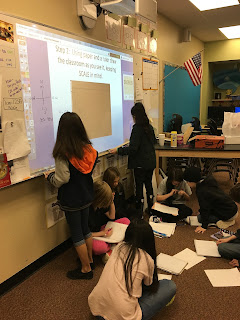This week, we kicked off our first PBL (problem-based learning) unit for the year, Designers 4 Mobility, with a visit from 2 wonderful people and a dog, all eager for our students to take on a problem they are currently facing.
Freedom Service Dogs is an organization that takes shelter dogs and trains them as service dogs for veterans and clients with mobility impairments.
 |
| Freedom Service Dogs guests Marie and service dog-in-training Yatzee |
Elizabeth "EB" Forst is a client awaiting a service dog from Freedom Service Dog who was paralyzed from the chest down 2 years ago in a diving accident.
 |
| Elizabeth "EB" Forst talking with students |
In speaking with Freedom Service Dogs' client relations manager, Marie, I learned of a problem they faced with clients who are quadriplegic: They cannot give their dogs treats as most people would- by using their hands.
Lo and behold the driving question for this PBL:
How can students design a way for clients who are quadriplegic to give their service dogs treats?
Sounds simple, right?
Students began with by hearing from our client, EB, as she told the students a story of her life both before and after a diving accident left her paralyzed from the chest down. Upon hearing her story, students began asking questions and brainstorming ideas to help EB when she receives a service dog of her own. They were in awe of her high-tech wheelchair, in which she controlled with various puffs of air into a straw-like device located near her mouth. Could they come up with a solution to her problem?
 |
| EB shows students the bells and whistles of her sip and puff chair |
After chatting with EB, students got to visit with Marie and a service dog-in-training, Yatzee, to learn about all the things service dogs can do for their owners. Opening doors, pulling out the laundry, and opening the refrigerator were just a few of the things they learned about. They were also introduced to clicker training, and how trainers use treats to reinforce the behaviors they want the dogs to perform. Can they come up with a way for a dog like Yatzee to receive his treats?
 |
| Yatzee shows off some of his skills |









